You won’t spend much time in carpentry or woodworking before you need a good table saw. With so many options out there, narrowing down the best table saw is tough. That’s where we come in. We’ve used and reviewed dozens of table saws over the years, so we’ll help you sort out what really matters and which models stand out from the crowd.
Best Table Saw Top Recommendations
- Best Overall: DeWalt DWE7491RS
↓ Jump to this Table Saw - Best Cordless: Flex FX7221-1J
↓ Jump to this Table Saw - Most Powerful: Skilsaw SPT99-11
↓ Jump to this Table Saw - Best for Woodworking: SawStop JSS-120A60
↓ Jump to this Table Saw - Best Cabinet Table Saw: SawStop Professional Cabinet Saw
↓ Jump to this Table Saw - Best for the Money: Skil TS6307-00
↓ Jump to this Table Saw
Jump to These Sections for More Information
- More Table Saws We Recommend
- What To Consider When You’re Shopping
- Frequently Asked Questions
- Why You Can Trust Pro Tool Reviews
Best Table Saw Overall
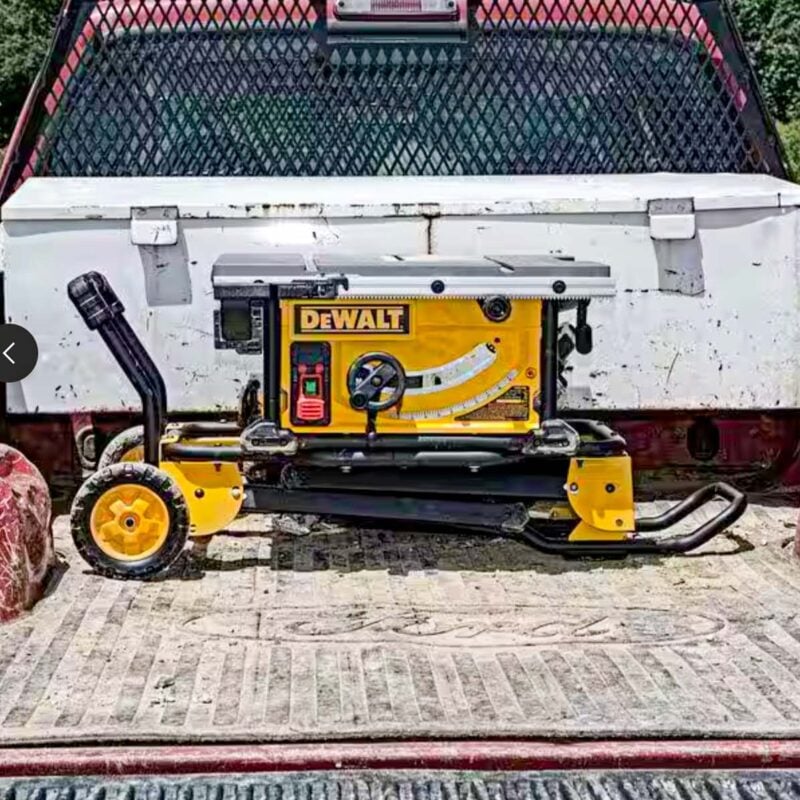
DeWalt DWE7491RS
- Motor: 2 HP, 120V, 15A
- Blade Speed: 4800 RPM
- Blade Diameter: 10 inches
- 90° Cut Capacity: 3 1/8 inches
- 45° Cut Capacity: 2 1/4 inches
- Dado Capacity: 13/16-inch
- Rip Capacity: 32 1/2 inches
- Price: $699
Pros
- Rack-and-pinion fence system
- Generous rip capacity
- Solid accuracy
- Very good dado capacity
- Included a well-matched stand
Cons
- Not as deep a cutting capacity as some models
- There are lighter, more compact alternatives
- Stand legs fold one at a time
- Significant price increase recently
Even though it’s more than a decade old, DeWalt’s DWE7491RS continues to be one of the top-selling table saws on the market. Very few power tools have that kind of staying power, and it’s due to a time-tested design that meets a wide range of needs.
It’s a design that’s so good, you’ll find elements from this model on most other portable table saws on the market. The rack-and-pinion fence system took the guesswork out of fence calibration. The wide rip capacity made cutting sheet goods more convenient. Decent dado capacity made it relevant for woodworking. The perfectly paired stand made transportation easier and added value to the package.
That’s not to say it’s a perfect design, though. The lack of a soft start and stand legs that have to be folded one at a time are minor strikes against it. You also need to slow your feed rate in some hardwoods more than some models to avoid stalling the motor. And while it excels in the portable class, if the highest precision or production-level work is your goal, it’s no replacement for a quality cabinet saw.
That said, it’s a dependable workhorse of a table saw. If you’re looking for a corded portable model, it’s the best overall package available.
Best Cordless Table Saw
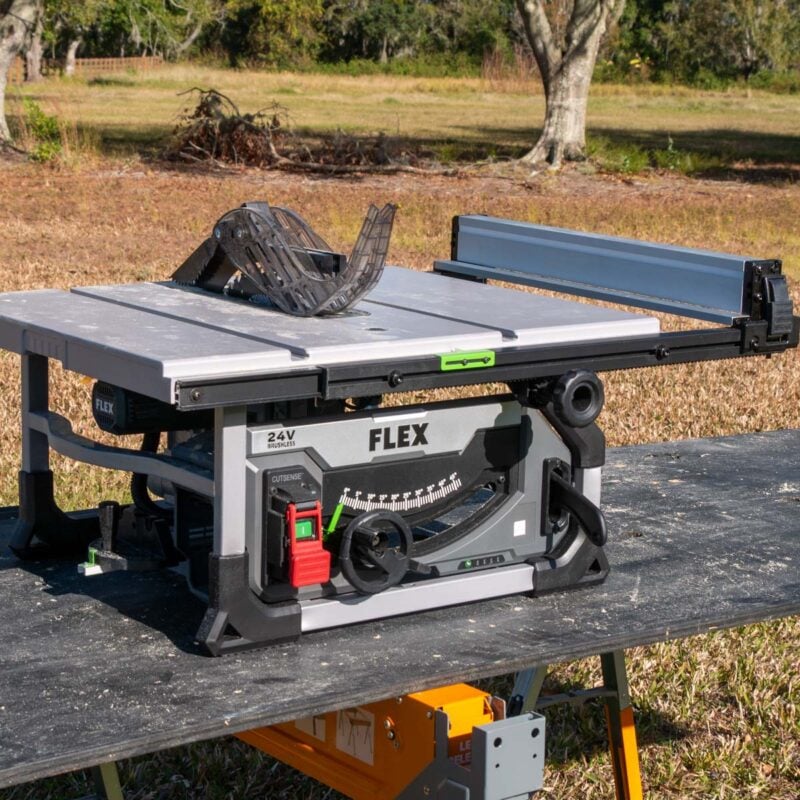
Flex 24V FX7221-1J
- Motor: Brushless 24V
- Blade Speed: 5000 RPM
- Blade Diameter: 10 inches
- 90° Cut Capacity: 3 5/8 inches
- 45° Cut Capacity: 2 1/4 inches
- Dado Capacity: 13/16-inch
- Rip Capacity: 30.5 inches
- Price: $659 bare, $799 kit
Pros
- Hybrid cordless or corded operation
- Low blade chatter under load
- Rack-and-pinion fence system
- Rechargeable fence LED light
- CutSense automatic blade stop
- Generous rip capacity
- Solid accuracy
- Very good dado capacity
- Lifetime warranty with registration
Cons
- Expensive to get full cordless and corded capability
- AC adapter is sold separately (~ $219)
There are a number of quality cordless table saws available from Milwaukee, DeWalt, and others. Metabo HPT moved the benchmark by creating the first hybrid cordless/corded model. But today, Flex holds the crown as the best cordless table saw.
As the larger of two models that launched at the same time, Flex wrapped in a solid full-size design with a rack-and-pinion fence, cutting depth that can cut 4x lumber in one pass, and hybrid power functions with smooth, confident cutting performance.
But Flex went even further, adding two more innovations we hadn’t seen previously. A rechargeable LED light on the fence might not seem like something a table saw needs, but it’s surprisingly effective, especially if you’re dealing with hard shadows or low light.
They also developed CutSense. This technology senses when you complete the cut and automatically shuts the motor down. It’s not designed as a safety feature like SawStop’s flesh detection. Rather, it primarily helps preserve battery runtime. As a bonus, you can turn it off if your running corded or making serial cuts in quick succession.
Most Powerful Table Saw
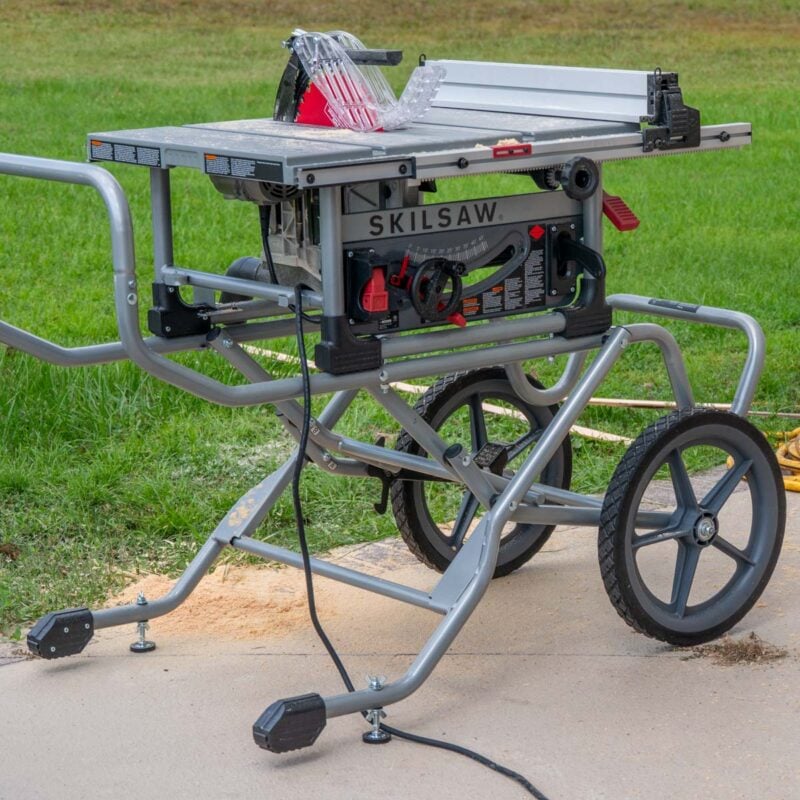
SKILSAW SPT99-11
- Motor: 4.4 HP, 120V, 15A
- Blade Speed: 5000 RPM
- Blade Diameter: 10 inches
- 90° Cut Capacity: 3 5/8 inches
- 45° Cut Capacity: 2 3/10 inches
- Dado Capacity: 1/2-inch
- Rip Capacity: 30 1/2 inches
- Price: $749
Pros
- Worm drive motor delivers excellent torque
- Rack-and-pinion fence system
- Generous rip capacity
- Superb rolling stand with oversized wheels
Cons
- Dust port can clog when you’re not using a vacuum
When Skilsaw launched its 10-inch table saw, the design team didn’t try to reinvent the wheel, but built a solid platform with some of the most convenient features available. What they did to set it apart was install a genuine worm drive motor at the heart.
By going the worm drive route, it immediately gave Skilsaw the most powerful portable table saw on the market. Just like a worm drive circular saw, the motor design creates more torque than a direct drive. In practice, it’s more confident when you’re cutting thick hardwoods. At the same time, the blade speed is still on par with other Pro-grade table saws, so you’re not giving up cutting speed on less-demanding cuts.
Best Portable Table Saw for Woodworking
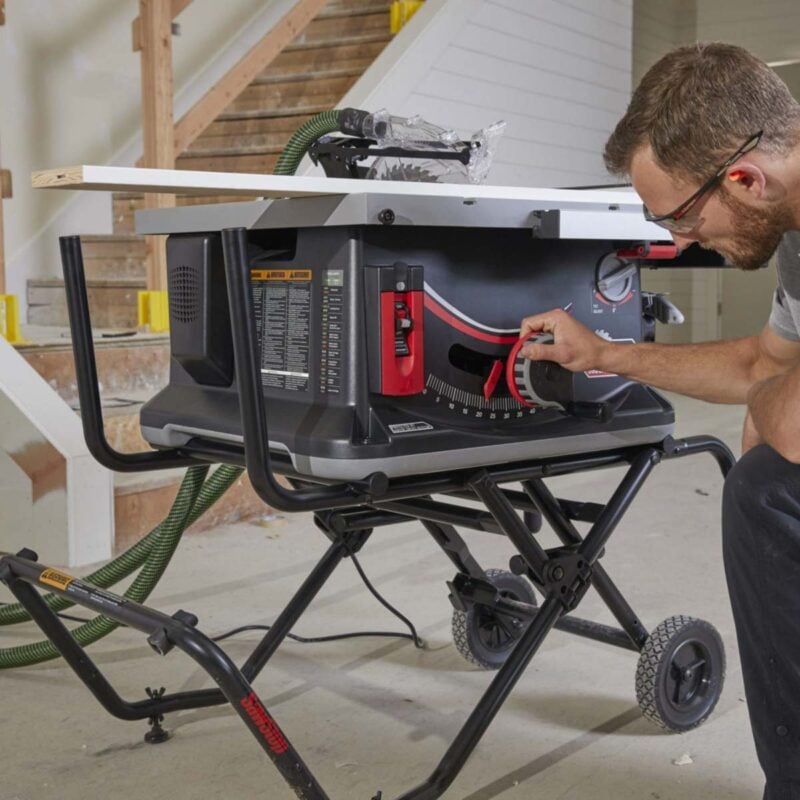
SawStop Jobsite Saw Pro JSS-120A60
- Motor: 1.5 hp, 120V, 15A
- Blade Speed: 5000 RPM
- Blade Diameter: 10 inches
- 90° Cut Capacity: 3 1/8 inches
- 45° Cut Capacity: 2 1/8 inches
- Dado Capacity: 13/16-inch
- Rip Capacity: 25 1/2 inches
- Price: $1699
Pros
- Flesh detecting blade stop mechanism
- Excellent cutting performance
- Smooth, accurate T-style fence
- Fast blade height adjustments
- Micro bevel angle adjustments
- Active dust collection system improves dust removal
- Deeper table than most
- Innovative accessory storage bins
- Solid stand design
Cons
- Expensive
- Blade and cartridge replacement required when safety system engages
- Wet wood or other conductive materials will likely trigger the blade brake if not bypassed
- Not as deep a cutting capacity as some models
- Larger footprint than other 10-inch models
Whether it’s a matter of space or budget, most woodworkers start with a portable or benchtop table saw. For woodworkers who need more than a jobsite model can offer, SawStop’s JSS-120A60 effectively bridges the gap between portable and cabinet saws.
Of course, Sawstop’s claim to fame is its impressive safety system. By detecting a flesh strike, it drops the blade below the table and jams it into a brake, stopping in less than 5 milliseconds. We tested it, and it really does work.
But SawStop’s table saws are more than just a safety feature built into what everyone else has. They make genuinely great saws. In this case, woodworkers will enjoy the smooth, accurate T-frame system, fast blade height adjustments, and micro bevel angles adjustments that other portable models don’t have. It also has excellent cutting performance, including in hardwoods.
With all the innovation packed into this saw, it’s understandable that it’s more expensive than others in its class. But how much does a trip to the ER cost these days? How much are your fingers worth to you? For many people, the added insurance is worth the cost.
Best Cabinet Saw for Woodworkers

SawStop Professional Cabinet Saw
- Motor: 3HP, 230V, 13A,
- Blade Speed: 4000 RPM
- Blade Diameter: 10 inches
- 90° Cut Capacity: 3 1/8 inches
- 45° Cut Capacity: 2 1/4 inches
- Dado Capacity: 29/32-inch
- Rip Capacity: 36 inches
- Price: $4028
Pros
- Flesh detecting blade stop mechanism
- Confident cutting performance in all woods
- Accurate T-Glide fence system
- Optional T-Glide Advance improves fence versatility
- Optional blade guard offers highly efficient top-mounted dust collection
Cons
- Expensive
- Requires a 220V power source
- Blade and cartridge replacement required when safety system engages
- Wet wood or other conductive materials will likely trigger the blade brake if not bypassed
With brands such as Grizzly, Powermatic, and Sawstop dominating in terms of model options, narrowing it down to just one model for the best cabinet table saw proved to be a challenge. As I filtered through the options, it came down to SawStop’s Professional Cabinet Saw and Powermatic’s PM2000BT Table Saw.
Allow me to make a high-level case for both.
SawStop has its well-known flesh detecting safety system, and that’s likely the end of the argument for some people. While this saw isn’t new, SawStop does have a new advanced T-Glide fence system that maintains the previous version’s accuracy while making it more versatile for things like accessories and jigs.
The downside is that adding the new fence makes the saw’s already premium price tag even higher—topping out at more than $4000 if you go with the 3HP model (which we recommend). Plus, you need to keep additional blades and cartridges on hand in case the AIM system triggers.
In Powermatic’s corner, the PM2000 has more iterations to meet your specific needs, higher available power (3HP or 5HP), and a digital angle readout. Upgrading with the recent ArmorGlide coating makes feeding easy while preventing rust on the table. Plus, adding the Accu-Fence system gives it some of the best precision on the market.
Against it, this saw doesn’t have a blade-stopping safety system like SawStop, and the price tag of our recommended 3HP configuration is close to $6000. You can shave ~$800 off if you skip the ArmorGlide coating, but that’s still well over SawStop’s price.
For my money, I’d go with SawStop. I appreciate the finger insurance, the lower price tag, and it’s a darn good saw. On the other hand, if the highest precision is your top priority, Powermatic is the better buy.
Best Table Saw for the Money

Skil TS6307-00
- Motor: 120V, 15A
- Blade Speed: 4600 RPM
- Blade Diameter: 10 inches
- 90° Cut Capacity: 3 1/2 inches
- 45° Cut Capacity: 2 1/2 inches
- Dado Capacity: 5/8-inch
- Rip Capacity: 25 1/2 inches
- Price: $329
Pros
- Good cutting power
- Built-in folding stand
- Rack and pinion fence adjustment
- Parallel blade alignment micro-adjustments
- Excellent value
Cons
- A little less dado capacity than premium models
- No wheel on the integrated stand
The big deal surrounding Skil’s TS6307-00 is what you get for the price. With a 15-amp motor and 4600 RPM operating speed, it has more power than other DIY table saws that opt for smaller motors. We ran lots of material through it, and it cuts authoritatively. With its rack and pinion fence adjustment, onboard tool storage, and blade height/bevel adjustments, you can easily see the Pro-inspired design elements from contractor-grade models. It provides good accuracy and easy adjustability for a variety of cuts.
One big difference is that the integrated folding stand doesn’t have wheels, but the saw is still light enough that I could easily load it into the back of my F150 without hassle. When you consider the performance and feature set against the $329 price tag, Skil is an easy choice as the best table saw for the money when you’re getting started.
More Tables Saws We Recommend
Bosch GTS15-10 Table Saw

- Motor: 120V, 15A
- Blade Speed: 3800 RPM
- Motor: 120V, 15 amp
- Blade Diameter: 10 inches
- 90° Cut Capacity: 3 9/16 inches
- 45° Cut Capacity: 2 1/2 inches
- Dado Capacity: 13/16-inch
- Rip Capacity: 32 1/8 inches
- Price: $699 with stand
The Bosch 4100-series table saws have been a staple on jobsites for years. However, the more recent GTS15-10 jobsite table saw makes several key upgrades. It brings the blade speed up a little, improving the cutting speed in softwoods, but without giving up much torque for cutting hardwoods.
More notably, it has the rack-and-pinion fence system that previous models skipped. As a contractor-focused saw, that makes it much easier to use, especially for crewmembers who might not be as skilled at properly setting traditional fence designs.
Add in a new Clamp Zone for securing material and increased capacity to cut 4x lumber in one pass at 90°, and it’s a significant upgrade from the 4100-series.
From there, Bosch packs it into a high-value package that includes a quality gravity-rise stand. It’s a solid workhorse of a portable table saw that you can depend on day in and day out.
Festool CSC SYS 50 Cordless Table Saw

- Motor: Brushless (Two 18V batteries required)
- Blade Speed: 4500 – 6800 RPM
- Blade Diameter: 6.3 inches
- 90° Cut Capacity: 1 7/8 inches
- 45° Cut Capacity: 1 11/32 inches
- Dado Capacity: 13/16 inches
- Rip Capacity: 11 inches
- Price: $1589 – $2119
Festool is one of the most well-recognized brands among professional woodworkers and carpenters. In 2023, Festool moved into the battery-powered table saw category with the CSC SYS 50. Like most products the company makes, it’s a sophisticated tool that’s surrounded by a system of components and accessories. Unlike the other saws on our list, this one is purpose-built for interior finish work.
What you get is a saw that spins its small 160mm (6.3 inch) blade at speeds between 4500 and 6800 RPM. Variable speed is a nice luxury to have, but it’s valuable if you’re going to produce the highest-quality results for your most demanding clients.
Then, Festool gives you a digital depth control that can set blade depth with up to 1/256-inch accuracy. Crazy, right? You can also store and recall up to four different blade depths, making repetitive cuts easy to replicate. The variable blade speed is also set using the digital controls.
Festool’s amazing dust collection makes this one of the cleanest table saws on the market—even without a top guard collector.
It weighs just over 33 pounds, making it incredibly portable for on-site carpenters
Overall, it’s a well-designed saw built to do a specific job at the highest level. If high-end interior finish work is what you do, it may well be worth the price.
Metabo HPT 36V MultiVolt 10 in Table Saw C3610DRJQ4
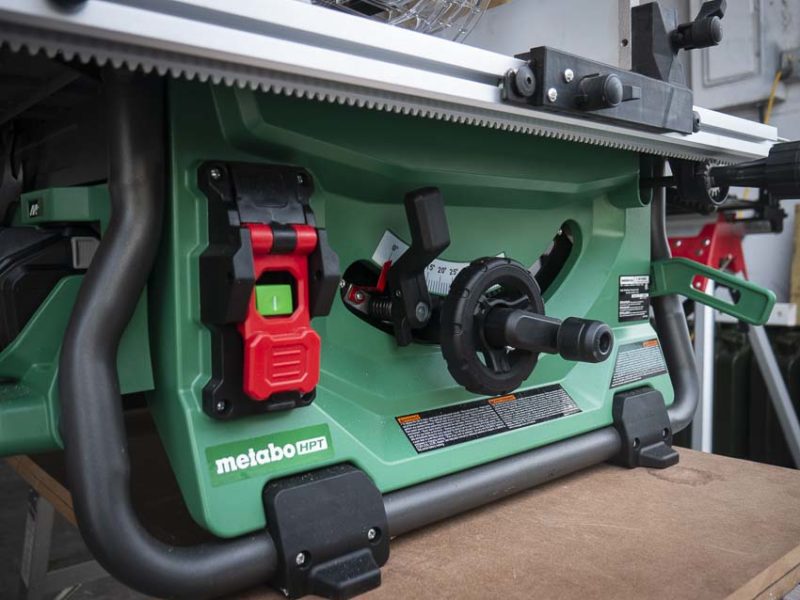
- Motor: 36V brushless
- Blade Speed: 5000 RPM
- Blade Diameter: 10 inches
- 90° Cut Capacity: 3 1/8 inches
- 45° Cut Capacity: 2 1/4 inches
- Dado Capacity: 13/16 inches
- Rip Capacity: 35 inches
- Price: $659 bare
Metabo HPT built their cordless table saw on the foundation of their own corded design and gave us a bonus—hybrid power options. You can run the saw using either a Metabo HPT 36V battery or their AC adapter. That in itself is a big deal since you can use the power source that’s the most convenient for the job.
The rest of the design doesn’t stray far from the norm, but it does have all the proper bases covered, including a rack-and-pinion fence system and a generous table size with outfeed support.
Milwaukee M18 FUEL 8-1/4 in. Table Saw 2736

- Motor: Brushless 18V
- Blade Speed: 6300 RPM
- Blade Diameter: 8.25 inches
- 90° Cut Capacity: 2 1/2 inches
- 45° Cut Capacity: 1 3/4 inches
- Dado Capacity: 3/4-inch
- Rip Capacity: 24.5 inches
- Price: $499 bare, $649 kit
Milwaukee’s M18 Fuel table saw was a revelation when it first launched, upping the performance level over DeWalt’s 60V Max model and integrating One-Key for management and tracking applications. Even though it has more competition today, it’s still a darn good saw.
As a compact model, it doesn’t have the cutting depth or table size of a 10-inch saw. However, it knows its purpose, and its high blade speed cuts material efficiently while its PowerState brushless motor keeps those RPMs up when you’re cutting hardwoods. In fact, when we tested side-by-side against a 15-amp corded model, we found it could match the performance.
There’s not much to complain about the design unless you need the cutting depth or the larger table of a full-size saw. Of course, that begs the question—with M18 Forge batteries offering even higher performance, how long will we have to wait for an M18 Fuel 10-inch table saw?
Ridgid R4514 Table Saw

- Motor: 120V, 15A
- Blade Speed: 5000 RPM
- Blade Diameter: 10 inches
- 90° Cut Capacity: 3 1/2 inches
- 45° Cut Capacity: 2 1/4 inches
- Dado Capacity: 3/4-inch
- Rip Capacity: 30 inches
- Price: $549
Ridgid currently has a couple of table saws available at Home Depot. While the R4518 is compelling because of its low price tag, most Pros will be happier with the larger and more capable R4514. It has a deeper cut capacity, allowing you to cut 4x lumber in one pass, along with a larger table for material support.
Additionally, the stand that comes with the R4514 is much better for jobsite use. Its gravity rise design is easier to set up and take down, and the wheels make transportation a one-man job.
I’m sure you’ve noticed how much prices have gone up over the past few years. Still, the Ridgid R4514 is the best value on the market for Pros on the hunt for a solid contractor saw. Plus, it’s backed by Ridgid’s Lifetime Service agreement.
Ryobi RTS08 Compact Portable Table Saw

- Motor: 13A
- Blade Speed: 5700 RPM
- Blade Diameter: 8 1/4 inches
- 90° Cut Capacity: 2 1/5 inches
- 45° Cut Capacity: 1 3/4inches
- Dado Capacity: Not recommended
- Rip Capacity: 12 inches
- Price: $149
If you’re looking for an affordable table saw to learn on or to tackle weekend projects, it’s hard to pass up the $149 Ryobi RTS08. At that price, you can expect trade-offs compared to higher-priced saws. The 13-amp motor isn’t as strong, the cut capacity is lower, and the table size isn’t as large.
On the other hand, this is a lightweight option at 45 pounds, and by swapping out the stock blade for a quality replacement, you can achieve good results. Just keep your feed rate under control and let the motor keep its RPMs up.
What to Consider When You’re Shopping for a Table Saw
Types of Table Saws
Before you shop, it helps to understand the different types of table saws, so you know you’re getting the right one for your needs (and what you might want to upgrade to later). Here are the main types of models you have to choose from:
Jobsite Table Saws
These are the least expensive types of table saws, also labeled as “benchtop” or “compact.” Lightweight and compact, these tools are easy to move and store. Some of them are extremely lightweight (less than 50 pounds) and come with a quickly removable stand. They work best when you want a saw that quickly drops into your pickup or work van. Other portable saws that weigh more come with rolling stands, letting you roll them on and off a trailer.
Contractor Saws
Larger than a benchtop model, a contractor saw offers more power and stability for larger jobs. These tools are less portable than a jobsite table saw, but you can cut larger pieces of wood. Contractor saws have open bases and a stand to provide a larger surface for working on oversized projects.
Cabinet and Sliding Saws
Next to a sliding saw, a basic cabinet table saw is the most expensive option made specifically for power and precision. Cabinet saws have heavy-duty stationary bases, dust collection ports, precision adjustment capabilities, and powerful motors. Their closed bases are often made out of cast iron, and they often weigh around 600 pounds.
Taking the next step forward, a sliding table saw adds a sliding section of table, and is typically used in production settings. When you’re cutting particularly heavy material, it glides far more easily than having to overcome the friction of the table surface when you’re pushing the material itself. Even when you’re cutting lighter material, it can help improve the consistency of your cutting accuracy.
Hybrid Table Saws
Some tools combine features from contractor and cabinet table saws and are considered hybrid saws. They allow you to have some of the best features of cabinet saws, like an enclosed case, but they don’t have as much power.
Blade Size
Most table saws have either 10-inch or 8 1/4-inch blades. The blade size is most commonly related to the table size rather than. Recent regulatory changes require a minimum table size to use a 10-inch blade, so the most compact saws have all shifted to 8 1/4-inch blades to meet the new regs.
Unless the job requires you to use a compact saw, we recommend going with a 10-inch model. These cut up to 3 1/2 inches deep at a 90° angle (enough to cut 4x lumber in one pass) and 2 1/2 inches at a 45° bevel. If you use a smaller blade, you won’t be able to cut as deep.
Motor Power and Blade Speed
The motor size is a good place to start when you’re trying to determine how much power a table saw has. For most portable models, anything with a 15-amp motor is fine. DIYers can get away with 13-amp motors, but there is a noticeable difference in cutting confidence.
Once you jump up to cabinet saws, you start getting into 220V motors and the potential of moving beyond single-phase designs. For those models, the horsepower rating is helpful, with 3HP offering excellent mid-range performance and 5HP or more being the standard for production shops.
When it comes to blade speed, keep in mind that higher numbers aren’t always better. For example, 5500 RPM on an 8 1/4-inch saw isn’t necessarily better than a 5000 RPM 10-inch model. The smaller blade has to rotate faster in order to get the same edge (tooth) speed as the larger blade.
There’s no solid benchmark for blade speed. We’ve used 10-inch saws with 3800 RPM and 5000 RPM with equally solid results. It’s more about the motor’s ability to maintain the blade speed when you’re cutting denser, thicker wood. As long as it doesn’t bog down, you should be in good shape.
Fence
The fence design of your table saw is critical to the accuracy of your cut. Basic models can be tough to lock down parallel, and some can wobble as you feed material through. It’s one thing to have a little inaccuracy when you’re framing, but woodworkers typically need the highest precision their budgets allow for.
For most people, a rack-and-pinion fence system is the easiest to use. Once you ensure its accuracy through the calibration process, the fence stays in place and the table moves, eliminating many of the issues.
T-style fences, such as the ones SawStop uses and from brands like Biesemeyer, are more common on premium saws or as upgrades. Designed to lock down tight with no flex as you feed, they connect on just the front side of the table and self-align when you lock them down.
Rip Capacity
The rip capacity is the distance from your blade to the farthest point the fence can reach on the saw’s right side. Having at least 25 inches of rip capacity ensures you can cut sheets of plywood in half. However, the more, the better, since additional capacity means additional material support as you feed.
When you move up to cabinet saws, you have the option of much greater rip capacity—50 inches or more. This is helpful when you want to cross cut sheet goods across their longer side, like when you want to turn a 4 x 8 sheet of plywood into two 4 x 4 sheets.
Bevel Angles
The blade on a table saw tilts right or left, but not both ways. It’s a matter of personal preference, but there are advantages and disadvantages either way. Typically, you will have around 45° – 48° of range in order to cut bevels and angles for drawers, cleats, and more.
More important is the bevel mechanism. It determines how easy and how accurate your beveling will be. Keep in mind that all table saws need calibration out of the box and on an occasional basis. From there, the bevel system will play heavily into your accuracy.
Dado Capacity
Dado blades are used for making wide channeled cuts for interlocking pieces of wood together. The dado capacity refers to the width of the blade set. The dado capacity varies, usually with the strength of the saw’s motor.
Not all table saws are compatible with dado blades, though. For ones that do, a 1/2-inch dado is a good starting point, while stronger saws can have just under 1-inch capacity. Take a look at some dado projects online and see if that’s something you might be interested in learning, so you now whether your saw needs that capability.
Safety Features
Safety is always a priority when operating power tools. Look for a saw that comes with a blade guard, a riving knife, anti-kickback pawls, and an emergency shut-off switch.
Table saw accidents are common in the United States. Each year, about 40,000 accidents result in hospitalizations, and 10% of those result in amputations or disabilities. Here are the top safety tips for operating a table saw:
- Wear safety glasses.
- Install the blade guard before operating.
- Use push sticks and push blocks when making cuts close to the blade.
- Always disconnect the power before changing the blade.
- Stand to the side when making cuts to avoid accidental kickbacks.
Avoid accidents by learning more safety tips before operating a table saw.
Why You Can Trust Pro Tool Reviews
We’ve been in business since 2008, covering tools, writing reviews, and reporting on industry news in the construction and lawn care industries. Each year, we bring in and review more than 350 individual products. Our team will put our hands on hundreds of additional tools at media events and trade shows throughout the year.
We won’t recommend anything unless we’d use it ourselves, and we don’t care who the primary retailer is. It’s all about giving you a legitimate recommendation and our honest opinion of each product.
Our site will provide more than 500 pieces of new content this year absolutely free for our readers. That includes objective evaluations of individual tools and products. The result is information you can trust because of the editorial, scientific, and real-world professional experience we collectively utilize each time we pick up and test a tool.




As a contractor who owns both saws, nothing about the M18 “ups the performance” of the Flexvolt.
Ergonomics and size, sure. But the Flexvolt is a clear winner on performance and capability. The M18 bogs under easier conditions and goes through batteries much quicker.
Both great saws, however. Very curious about the Flex, but I worry about the longevity of the company and how that will affect parts and battery availability.